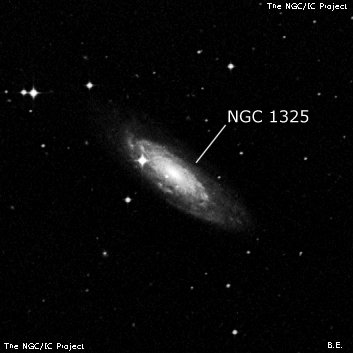
William Herschel discovered NGC 1325 = H IV-77 = h2534 on 19 Dec 1799 (sweep 1091), describing "a star about 9 or 10m with a nebulous ray to the south-preceding side. The ray is about 1.5' long. The star may not be connected with it." John Herschel described and sketched this galaxy from the Cape on 11 Nov 1835: "A complete telescopic comet; a perfect miniature of Halley's, only the tail is rather broader in proportion; mE; 90" l; the star at the head = 10 mag. See fig 17, Pl VI."
Joseph Turner sketched the galaxy on 15 Nov 1875 using the Great Melbourne Telescope (unpublished plate II, figure 8 1/2). He noted it appeared "much fainter than Herschel's sketch shows it - It seems to be much altered since he observed it." Instead of the tip of the galaxy at the brighter star (called "a perfect miniature of Halley's" by Herschel), Turner sketched a thin section of the galaxy, skirting around the start and extending further northeast.
300/350mm - 13.1" (10/10/86): fairly faint, pretty edge-on 3:1 SW-NE, weak concentration. A star is attached at the northeast end and a mag 13.5 star is 1.5' SE of center. Located in a small group with NGC 1319 6.8' W and NGC 1325A. NGC 1325A is faint, moderately large, round, but very diffuse.
400/500mm - 17.5" (12/28/00): bright, large, elongated 5:2 SW-NE, 3.0'x1.3', broad concentration with a large, brighter core. A mag 11.5 star is embedded in the northeast end. The southwest end is better defined and clearly tapers down, giving a lens-like appearance. The edge of the halo is more ill defined to the northeast of the star.
Second brightest in the NGC 1332 group with NGC 1319 7' W, NGC 1325A 13' NNE, NGC 1315 21' NW and NGC 1332 29' ENE. NGC 1325A = Holmberg VI appeared faint, large, round, diffuse glow. Appears ~2' in diameter and brightens slightly but there is no noticeable core.
Notes by Steve Gottlieb